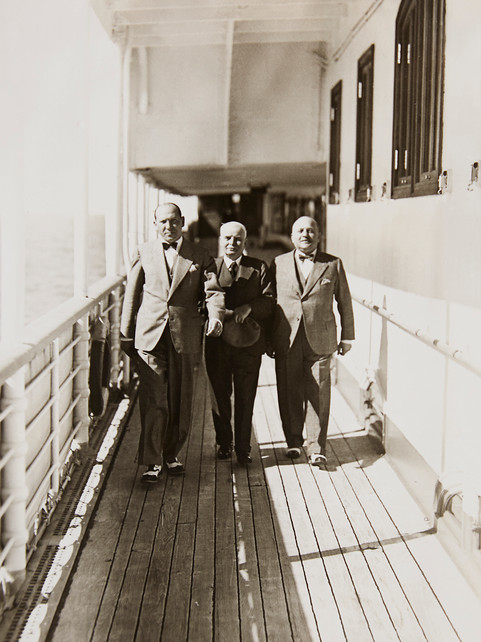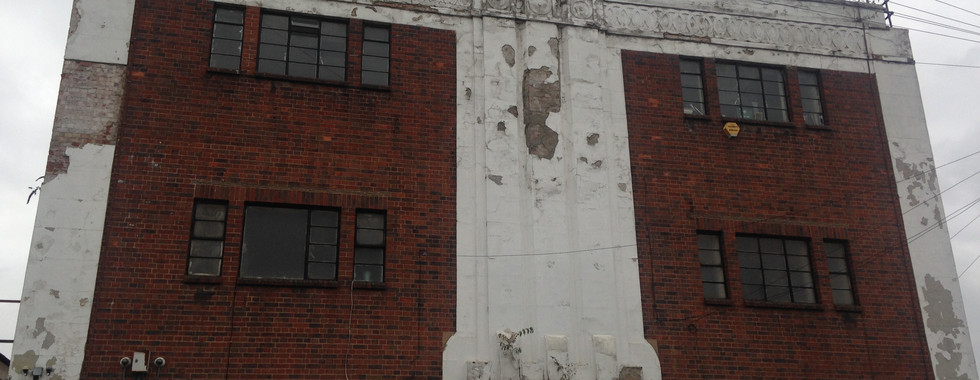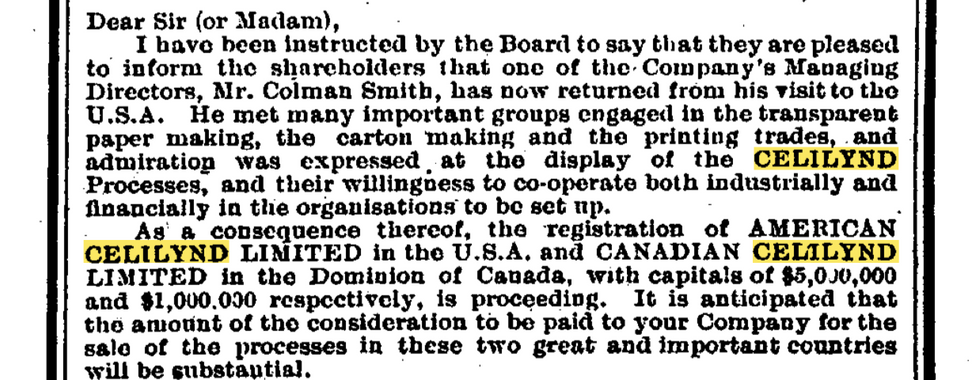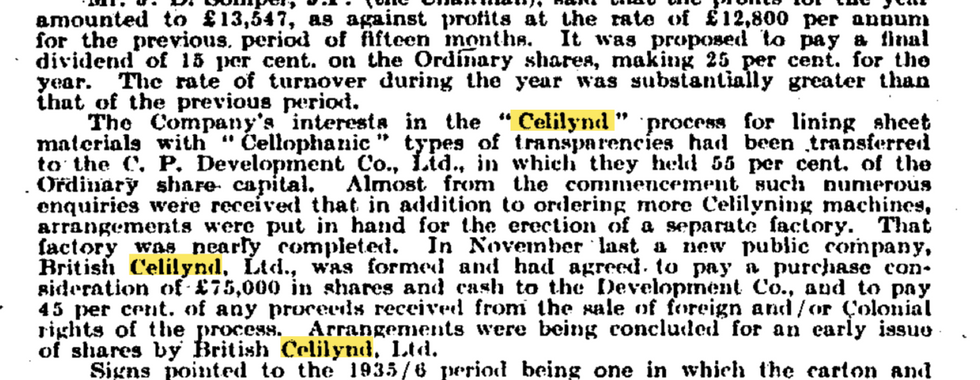THE HISTORY OF D SMITH AND SONS
Updated: Aug 30, 2022
By Steve Smith
Until fairly recently I knew almost nothing of Gabriel and Colman's original business, not even the name, D Smith and Sons, just a vague knowledge that they had a successful box making business, and invented some packaging processes before going out of business. I'd even unknowingly been past what was their factory on Lea Bridge Road a number of times, recently demolished. I paid a visit to the site, but sadly out of the two factory premises they built, one to make the boxes and the one next door to deal with the Celilynd process, only the Celilynd building was still standing and I couldn't gain access to the interior itself.
It also became more apparent just how central it was to them and their lives, it really was the family business. So it's been fascinating to find out more and I've tried as much as I can to collate all that we know to date, from articles in The Times, researched initially by Jeff, my own searches from The Jewish Chronicle, what knowledge has been passed down by various family members, especially the memoirs of Sylvia, so lovingly captured on video by her son Julian.
I have included citations to the source where possible and will add all the documents to a separate folder.
The origins of the business go back to David Zmidek / Smith and the earliest record we have is of him listed as a 'card box maker' of 32 Princes Square (see Cobbles) on his death certificate in September 1908. It's unknown whether this was his trade prior to him coming here in around 1902/3. In Poland, there is only one record of his occupation and that is as a labourer.
Gabriel and Colman are both listed as 'fancy card board ' makers and 'employers' on the 1911 census. On their application for naturalisation in 1921, they are listed as cigarette box manufacturers and states they acquired the business 'Smith and Sons' from their father, presumably after his death.
Exempted from national service during WW1 for doing work of national importance, they were contracted to the Ministry of Munitions to make munitions boxes and / or munitions belts, and possibly making uniforms as well. It seems that this contract was the basis of the business expanding and becoming successful.
At this time, the primary business address of the head office was at 19 Rupert St, Leman St E1, Aldgate. The street no longer exists (see map below, left). They had other premises at the following addresses: 34 St John St Hoxton (now Pitfield St) 390 Mile End Road , 407 Hackney Road, and 86 Old Bethnal Green Road. At this time the business employed over 300 people. Unfortunately, none of these buildings exist today, either from bomb damage during the war or later demolition
Map of Aldgate and St. George in the East. Rupert Street: top left, Princes Sq. where they lived: bottom right

In 1924, the company was renamed D. Smith and Sons (1924). It continued to grow and went public in 1928, resulting in them building a new, purpose-built state of the art factory at 97 Lea Bridge Road in 1930. It's noted that Jan 31st 1931 was 'not a good month for stock taking' as they were relocating there.
Location of the factories at Lea Bridge Rd. The larger building fronting Lea Bridge Rd itself is the box-making plant, the smaller building above it is the Celilynd Building

The factories, Lea Bridge Rd runs top to bottom on the left

In August 1932, the shareholders were informed of a large contract being negotiated, and that the 'directors are negotiating to acquire a similar business with a view to extending and augmenting the companies business' and the outlook is considered bright.
Statement by the chairman G Liverman, in the JC, Dec 15 1933:
'The accounts showed the profits had substantially increased, the company possessed a very fine factory which was well equipped with thoroughly up-to-date plant enabling them to handle efficiently the companies growing business.'
They had concluded further negotiations with an 'important customer to extend their contract to the benefit of the business for a number of years.
'The company's connections were developing into a large variety of trades with widespread interest to the benefit of the company.'
This continued expansion, making not only cigarette boxes but boxes for all purposes, allowed them to prosper and afforded them quite a life of luxury, with large houses next to each other in Cazenove Rd, Stoke Newington, where chauffeurs would collect them and drive them to the factory.
At some point in 1933, Gabriel had the idea to cover the boxes in cellophane to 'keep tobacco fresh' and a process was developed to laminate the printed boxes with the cellophane. From his basic idea and the ingenuity of his staff, they worked out that if the adhesive being applied was done so in a lattice work pattern, the ink on the underlying printed surfaces would not bleed, thus enabling, for the first time, printed boxes to be laminated. A significant technological discovery for its day

In 1934, Gabriel, on behalf of the company protected the patent for this new invention:
'An entirely new process for lining sheet materials, such as cardboard strawboard cloth and paper with cellophane types of transparent paper, which would have far reaching consequences to the considerable benefit of the company.' (The Times)
They called this process Celilynd, and a new company, British Celilynd, was formed to deal with this side of the business in 1933 / 1934 (The Times), by which time the company was making 250 million boxes a year, in comparison with 30 million in 1924.
In 1934, the shareholders were informed of the sale of rights to the Celilynd process 'for a territory in the Middle East' (presumably Palestine - see notice) for £20,000, based on negotiations for the sale of the American rights of the process, and also rumoured there was a possibility of the sale of continental rights.
D Smith registered a new company called Machinery (Smiths Patents) Ltd. to deal with new patents, particularly one for maturing and dusting board to increase productivity and health invented by both Gabriel and Colman.
American Patent files for Celilynd and the dusting machine

In 1935, the board sanctioned the building of a new factory for the Celilynd process in Burwell Road, next to the existing one in Lea Bridge Road, allowing them to increase production by around 50%. Wiggins Teape agreed to act as agents for the Celilynd process in the UK for 10 years.
In 1936, the company's interests in the Celilynd process were transferred to the C.P Development company, of which they held a 55 % stake.
'Almost from its commencement, numerous enquiries were received that in addition to ordering more Celilyning machines, the new factory had been built and was nearing completion, and with this increased factory accommodation, the directors were confident they would be equipped to deal with the anticipated increase in demand within the box making business.' (The JC)
In May 1936 they announced a new state of the art factory is to be built in B'nai Brak, near Tel Aviv, and the formation of a new company, D Smith and Sons (P and O.) Ltd. This new company had acquired the rights to the Celilynd process in Palestine and adjoining territories. The chairman and managing directors were all listed as being actively involved in this new business
Announcement of the new factory and Colman returning from Palestine with Co-directors Mr Kiley and JP Somper
They continue to expand and there was a new share issue in 1936.
On November 5th 1936, an article in The JC states the following:
'In a notice to the shareholders the board is pleased to say Colman has returned from the USA, where he met with important groups engaged in carton and print making trades and admiration was expressed for the Celilynd processes and had expressed a willingness to cooperate both industrially and financially in the organisations to be set up.'
As a result of this, the companies American Celilynd Ltd and Canadian Celilynd were both registered with capitals of $5,000,000 and $1,000,000 respectively. 'And it is anticipated the amount of consideration paid to the company (British Celilynd) for the sale of these processes in these two countries will be substantial.'

It is also noted that the directors were completing negotiations with an important French printing and carton making company for the sale of the processes to France and French territories.' (The JC) There is also a registration for the process in Poland.
All seemingly well, but in early 1937, concerns were first raised with the fluctuations of the share price in relation to the completion of the foreign rights in the USA, but D Smith continued to make good progress.
The story that has been passed down is that Colman had gone to the US to sell the patent and had messaged back on his return journey to say that the rights had been sold. The share price shot up at the news, but it was subsequently learned that this wasn't the case, there was another process and the Americans were no longer interested in Celilynd. The share price subsequently plummeted and the company devalued.
The impression I had was that this happened in a very short space of time, possibly on one single trip, but it seems it was a bit more involved and protracted than that. The patent is first registered in 1935, they were in negotiations in the US in 1936, the patent announced or listed in April 1937, and they didn't resign from the board until 1938. It also appears they were setting up companies themselves to buy the rights. These were funded and the processes were well received.
Which all really adds to the intrigue as to what actually happened, especially given that some of their co-directors apparently sold out and absconded to South America. Were they misled, or lied to? Was it a genuine misunderstanding or change of heart, or was there some collusion amongst those co-directors and someone in the US to defraud the company? But why would you do that when things are going so well in the first place?
I guess we'll never now know the full story.
What we do know is the family was left to pick up the pieces. Gabriel, Colman and Hyman Gerlis, who by that time was also on the board (The Times), were forced to resign from the company they had worked so hard and long to establish.
It's such a shame. After coming here with so little, lifting themselves up out of the poverty of the East End, building up a successful, innovative company that was developing internationally and leading the lives they did, to have ended in such a way.
Who knows where they may have taken it.
I think also that the fact that the Davids set up a new venture in the same business, which was extremely successful in its own right, using the Smith name, suggests there was no wrongdoing by the family, their reputation remained intact, and the name itself, or the Smith 'brand 'as it were, was not sullied.
Regardless of how it ultimately ended up, I feel immensely proud, as I know we all do, of what they achieved given their background. To think that the end result of penniless Jewish immigrants, coming here to the UK, arriving at the docks, with only what they could carry, started a business that has, through two separate incarnations, D Smith and Sons and then David S Smith Ltd, now DS Smith plc, become the largest packaging company in the UK, trading on the FTSE 100, and is one of the largest in Europe, and employs over 30,000 people world wide is staggering.
But at the same time I, and I'm sure others, have to be grateful too. If they had not gone out of business, the Davids would never have set up David S Smith Ltd, the factory in Neath would never have existed, and my mum would never have worked there....
Inside the factory at Lea Bridge Road. These were taken in the 1950's still D Smith's. Though no longer in the family's hands at this time, they give an indication of what it was like, possibly with the original machinery
Copyright Vestry House Museum

Boxes made from Celilynd

The box making factory entrance on Lea Bridge Rd and inside, 2016.
Photos by Lucy Harrison
The Celilynd Factory just prior to demolition, 2016.
Photos by Lucy Harrison
Articles from the JC archive - click for full screen and complete article
Research:
Times articles Jeff Kutcher
JC / photos etc. Steve Smith
Patent Marq Smith
Photos by Lucy Harrison
Lucy is an East London based artist who ran a research project into the building at 97 LBR, who provided the Vestry House images and research, and kindly arranged a site visit for me, though sadly after demolition had commenced, and only the Celilynd building was still standing in its entirety.
Co-incidentally including a factory in Kielce , the administrative district for Chmielnik, where the family originated. (see Kielce, Polish HQ of DS Smith)
Unconfirmed at the time of writing but we have discovered that David may have come to Britain in 1902 and was listed as a baker.
Recent Posts
See AllJeff Kutcher phoned Bill Burdett in June, 2020. You can listen to their conversation by clicking here. Bill Burdett was hired by Jack...




























































Comments